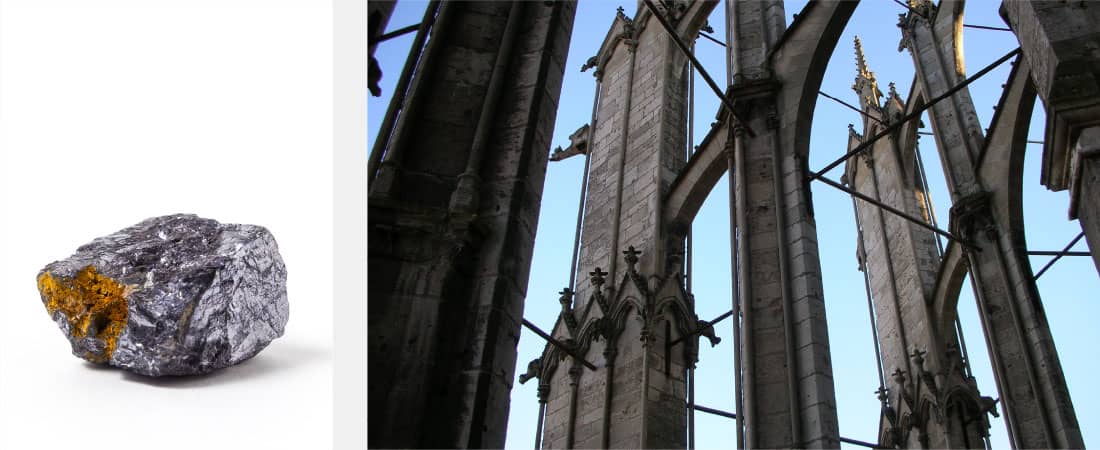
Migrations
Understanding ancient civilisations
PIGMENTS AND METALS
 Lucile Beck is head of the CEA Carbon 14 Measurement Laboratory (Climate and Environmental Sciences Laboratory).
Lucile Beck is head of the CEA Carbon 14 Measurement Laboratory (Climate and Environmental Sciences Laboratory).
 Philippe Dillmann is research director at the CNRS and deputy director of the UMR3685 “Nanosciences and innovation for materials, biomedicine and energy” (CEA/CNRS)
Philippe Dillmann is research director at the CNRS and deputy director of the UMR3685 “Nanosciences and innovation for materials, biomedicine and energy” (CEA/CNRS)
From time immemorial, man has shaped materials, both organic (deer antlers) and inorganic (flint, obsidian, pigments, glasses, metals, etc.), for different uses: tools, weapons, ornaments, construction, art… Understanding the evolution of the know-how involved in the various technical and cultural contexts is a major challenge for anthropology and history, notably in order to gain a clearer understanding of the relationship between man and his technical and natural environments and to identify the notions of innovation and culture, all of which are aspects to be put into perspective with our current societies. CEA’s laboratories are fully integrated into the interdisciplinary approaches today being developed in this field and the top-drawer analytical techniques developed within these laboratories are among today’s cutting-edge research tools. This can be illustrated by two recent iconic examples of the results obtained with these approaches: the study of cosmetics and pigments and work on ferrous metals.
But, this was to ignore the practices of the ancient craftsmen whose know-how involved ingredients of organic origin in the production of materials! Carbon 14 from charcoal is therefore found trapped in ancient irons and enables their period of production to be identified [2][2] DOI: 10.1017/RDC.2016.109.
After developing the dating of ferrous alloys in collaboration with the Archaeomaterials and Alteration Prediction Laboratory (LAPA), the Carbon 14 Measurement Laboratory (LMC14) [3][3] Plateforme nationale CEA/CNRS/IRD/IRSN/ministère de la Culture, UMR 8212 continues to innovate and carried out the very first dating of lead carbonates. These compounds are extensively present in our cultural heritage. In art and architecture, they are the components of the white paint used by European artists from the Greek period until the beginning of the 20th century. In archaeology, their presence in Antiquity and 18th century cosmetics indicate their use in the home. Lead carbonates exist naturally, but those used in paints or cosmetics were synthetic. The pigment or white powder was then called Venetian ceruse or lead white.
Our first evidence of the synthesis of lead white is described in a 4th century BC recipe by a Greek author, Theophrastus. To prepare lead white, fine slivers of lead metal are placed in contact with vinegar vapour in a fermenting environment (horse manure, wine lees, tannin, etc.). These are organic ingredients that will “mark” the lead white with carbon 14. The incorporation of the radioactive isotope into the pigment will then act as a chronometer.
Greek and Egyptian cosmetics were thus for the first time dated successfully in 2018 [4][4] www.nature.com/articles/s42004-018-0034-y [5][5] www.pourlascience.fr/sd/archeologie/datation-au-carbone-14-un-nouvel-outil-pour-etudier-lorigine-des-cosmetiques-antiques-14405.php. Carbon 14 dating confirmed the first chemical synthesis of phosgenite, a lead carbonate that is rare in nature (formula Pb2Cl2CO3), carried out in Egypt about 3,500 years ago. A pink blush consisting of lead white and discovered in the tomb of a young girl in Greece was also investigated. Dating of this cheek powder demonstrated that it was indeed synthesised between the 4th and 3rd centuries BC, using the process described in the recipe reported by Theophrastus. For phosgenite, the method of manufacture was revealed by a later recipe from Dioscorides, a Greek doctor and botanist from the 1st century AD [6][6] Walter et al, 1999. Making make-up in Ancient Egypt. Nature. 397:483-484. In both cases, carbon 14 was trapped but its source is not clearly identified in these recipes. It was not until the end of the 13th century that horse manure was clearly mentioned, thus providing a direct indication of a carbon dioxide atmosphere used to manufacture lead white!
This pigment was to last until the 20th century, when it was finally replaced owing to its toxicity. Dating lead white is thus a means of authenticating paintings more than two thousand years into the past: the potential repercussions for the art world are considerable! A thesis on this subject is currently in progress at LMC14. n
 More (2 min.)
More (2 min.)

© Getty Images and © P. Dillmann
Since the very beginning of metalworking this has used reducing compounds, carbon and its monoxide, provided by charcoal which, when it burns at high temperature in appropriate furnaces, combines with oxygen to release the iron metal. During this operation, some of the charcoal penetrates the metal to varying depths, leading to steel-faced zones. The researchers at the Archaeomaterials Research Institute of the CNRS (UMR 5060) and the Carbon 14 Measurement Laboratory set up a protocol to sample and extract this carbon, enabling objects to be dated by the age of the charcoal used to transform the ore into metal.
The first furnaces were also unable to achieve liquid metal, which therefore trapped non-metallic particles containing elements of the initial ore other than iron (silicon, aluminium, rare earths, etc.). The ratio of these elements in these inclusions is characteristic of that of the ore used. So, if we are able to quantify the elements, notably the rare earths, present within the impurities trapped in the ancient metals (this can be done using various mass spectrometry techniques), it is possible by means of sophisticated statistical processing, to compare this digital fingerprint (or chemical signature) with that of various ores found on the archaeological sites and thus propose hypotheses for the provenance of the objects. These two approaches (dating and provenance) were combined to deal with several historical problems: for example, the circulation and trading of iron at the time of the Gauls, the use of ferrous metals in the Khmer empire and in Angkor or the use of iron in the construction of the Gothic cathedrals.
In this latter example, the dating of the iron reinforcements identified by the archaeologists on the Gothic monuments (tie-bars through the vaults, wall ties, reinforcement bars), which could be up to several tens of tonnes per monument, showed that they were used as of the construction of the cathedral. The very idea of the typical monument of the Middle Ages (which has become a complex assembly of stone and metal) is now changed, as is our perception of how the men of the Middle Ages saw the principle of construction! To date, about twenty monuments have been studied, including the cathedrals of Beauvais, Amiens, Bourges and Rouen but also the Palace of the Popes in Avignon or the Belfry of the Brussels Town Hall. The provenance of the metal reinforcements was also determined in some cases, revealing complex procurement strategies, including recycling of materials, or the purchase of metals hundreds of kilometres from the cathedral construction site. n
 More (2 min.)
More (2 min.)

Migrations

Prehistoric rock art

New applications